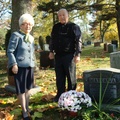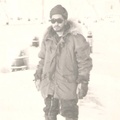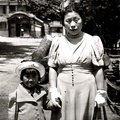Read Part 7 >>
Oshogatsu in Bridge River
All our staple food were unavailable to us anymore and all our mothers without recipes were experimenting, trying to make even miso, shoyu, kamaboko, manju, tofu, konnyaku, etc., but they didn’t taste the same anymore. The shoyu was good as the Chinese shoyu tasted like salty molasses. We were just a forgotten bunch of throw-away people.
But, somebody didn’t forget us. We heard that a ship came from Japan and the Japanese Red Cross sent some sticky mochi rice along with other things to the main internment camp. We pooled our rations for this one time “mochi tsuki” celebration. This is one good thing that happened to all of us to give us a lift. We really appreciated that. I’m sure the other internment camps enjoyed it too.
So, we were able to celebrate this one New Year in a real festive celebration gathering that included mochitsuki at the Bridge River Hotel. The men cut down a huge tree and sawed off a big stump which father and Mr. Honkawa (another relative from Prince Rupert) hollowed it like a deep dish using tools they brought over from Japan and smoothed it out with a rounded bottom plane and also made two huge mallets for pounding the steamed mochi rice that mothers cooked.
Mr. Honkawa used to design and build large fishing boats during the winter months when not fishing like many other Issei so many of them were really talented. When the war started the government confiscated all his boats like what happened to all the JC fishermen. The steamed rice was placed into the hollowed groove and two strong men would pound the rice taking turns and Ji-chan Oue would add water to the pounded rice in between the poundings and also shift the rice around with his bare hands singing or reciting something poetically with a melody until the rice finally became a sticky mochi.
The water was required so that the mallet head wouldn’t stick to the sticky rice and just the right amount had to be added for the proper consistency. They called this action “Aizu” for all three of them to work in unison and not anybody was able to do it. Everybody would gather around them joining in with rallying cries for the men to continue pounding the mochi in unison.
It sure looked dangerous for Oue-san and it’s a wonder his hands never got pounded! But it sure was exciting with everybody into it. It was real hard work and the pounders had to take turns. I’m sure the men’s sweaty salt drippings into the mochi made it taste even better. Just kidding—they were all dressed up for this occasion and tied towels around their foreheads, even Oue-san to give a real festive atmosphere. They made batches and batches!
The mothers used to cut them into pieces, rolled them into different sized balls, and then would flatten them a little. The first batch would be offered in front of the Butsudan, piled up in a pyramid form from the largest on the bottom to the smallest on top with a small orange on top. Mikan was no longer available. The mothers would then lay the mochi on wire meshes over the wood stove flames and we all had a fill of mochi which we dipped into a sugary shoyu mixture—yummy! Mochi was really good in soups too. Another thing, while the mochi tsuki men were pounding the rice, before it got too sticky, the ladies told them to stop and whisked it away to make azuki mochi called “bota-mochi” and everybody just loved that too!
There was one really sad situation that stays with me from that forsaken place.
There was an older couple living in the attic of the hotel and the wife became ill and died. There weren’t any funeral parlors nor churches even close-by so the husband had to make arrangements to get a bulldozer from somewhere to have them dig a huge hole in the pasture and piled earth all around to create an outside crematorium. The men gathered a lot of dried wood and piled them up in a huge pile. My father and I think Mr. Honkawa built a coffin and some ladies sewed some black cloth to cover it and they tacked it on.
After a Buddhist funeral service at the hotel without a minister the casket was carried over to the makeshift crematorium. The casket was laid on top of the pile of woods and another service was held as the fire was started. The husband was feeding the fire and stoking it all night making sure that the casket stayed in the middle of the fire and didn’t tip. The next day he collected his wife’s ashes to be stored in a huge bottle used as an urn. This was the first time we saw anything like that and everybody was stressed out.
During the following days, many of the Issei told us many stories about funerals and one in particular interested us. They told us that before you go to heaven the ashes of the dead have to be buried in a cemetery and there wasn’t one so for sure her spirit will be wandering around until she’s finally put to rest. The spirit will be in a form of a fireball (called Hinotama) so we were told to be on the lookout every night.
We didn’t believe them but like fools we watched every evening and what do you know, one of the kids yelled, “There it is!”—We looked at where he was pointing and sure enough we saw the Hinotama (about 2 ft. in diameter) drifting along the rooftop of the hotel and it disappeared. We all did see it and they say that seeing is believing but it was hard to convince ourselves that we did actually see it. It was sort of scary and spooky for sure! We chalked it down as trick of the mind as the older sisters and brothers laughed at us. Regardless, I hope the husband was able to find a final resting place for his wife wherever he settled after the war.
Later, my father taught me carpentry during the internment days and his method was not to spoon feed me but taught me just the basics and showed me how to look into things deeper by myself and later gave me jobs to do around the Toronto house to maintain it. He even made me build storm windows for all around the house and also got me to help him build a garage. His influence helped me build confidence to tackle anything when it came to construction and other things in life. Good things just don’t happen: you have to work hard for it, I learned that from Dad.
The best advice Dad gave me was to always look at the “big picture” when making decisions as you may go off track and head the wrong way and you can re-steer onto the right path again. He said that it is critical to break it down to short term, mid-term, long term plans to reach your big picture goal. He told me that even the big picture can change while moving forward so change it as required and indeed I found that out many times later.
Another one was—“two heads are better than one.” For anything you want to accomplish, there are always several ways to do it so spend some time thinking about them—list them all, prioritize what action to take, and if it doesn’t work you’ll have alternatives. So, consider all input from all sources first. I tried to utilize all his teachings throughout my life so far and at work also. (All of this sure came in handy especially in design engineering and support at work. Dad was also responsible for helping me choose to go to Ryerson Institute of Technology to study Electronics Technology for three years as he brought in his nephew, Shig Oue for consultation. Around 1953 was just the right time getting into electronics as it was just starting to take off in that field and I’ve never regretted it since, thanks to Dad and Shig.)
© 2013 Frank Maikawa






